Snap Inc.'s Stakeholder Analysis and Business-Level Strategy Report
VerifiedAdded on 2023/06/06
|13
|3239
|183
Report
AI Summary
This report provides a comprehensive analysis of Snap Inc.'s business-level strategy and generic strategies, focusing on its stakeholder relationships. It identifies key stakeholders such as shareholders (e.g., BlackRock Inc.), customers (college students), competitors (e.g., Google, Facebook, Apple, Instagram), and the general public. The report delves into the behaviors and motives of these stakeholders, examining how they impact Snap Inc.'s organizational objectives. Furthermore, it outlines strategic programs for managing each stakeholder category, including communication strategies for shareholders, innovation strategies for competitors, transparency for consumers, and community engagement for the general public. The analysis highlights the importance of stakeholder management in achieving a sustainable competitive advantage for Snap Inc.
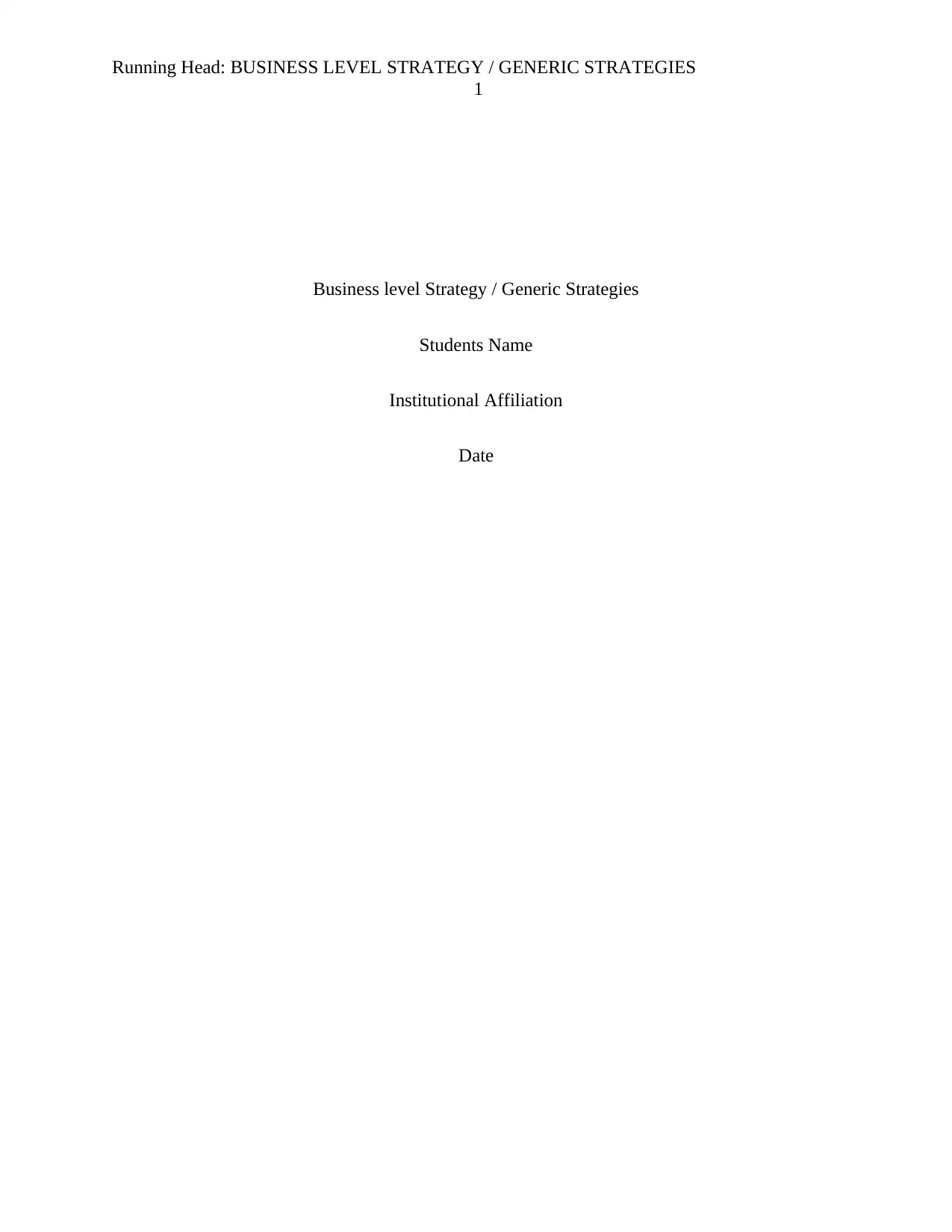
Running Head: BUSINESS LEVEL STRATEGY / GENERIC STRATEGIES
1
Business level Strategy / Generic Strategies
Students Name
Institutional Affiliation
Date
1
Business level Strategy / Generic Strategies
Students Name
Institutional Affiliation
Date
Paraphrase This Document
Need a fresh take? Get an instant paraphrase of this document with our AI Paraphraser
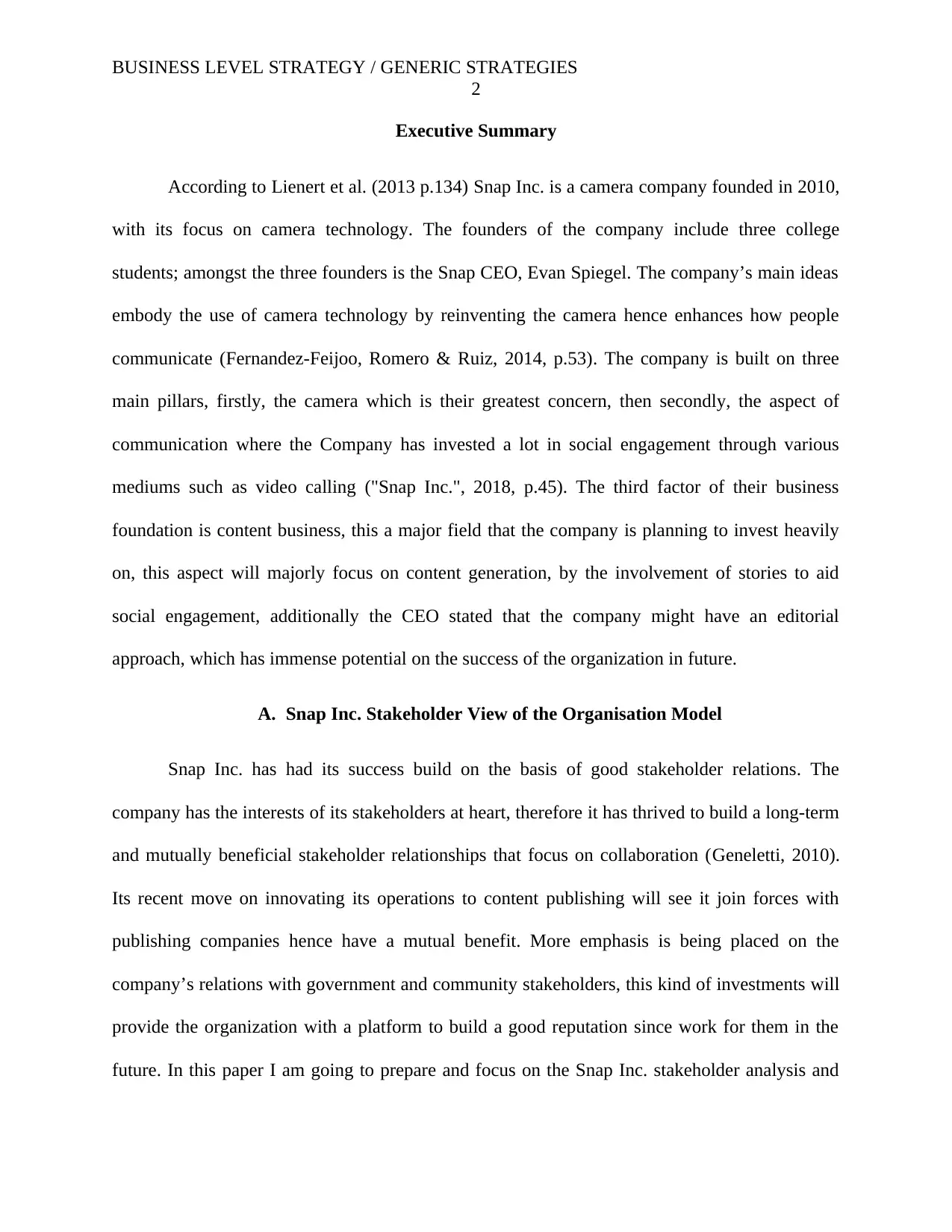
BUSINESS LEVEL STRATEGY / GENERIC STRATEGIES
2
Executive Summary
According to Lienert et al. (2013 p.134) Snap Inc. is a camera company founded in 2010,
with its focus on camera technology. The founders of the company include three college
students; amongst the three founders is the Snap CEO, Evan Spiegel. The company’s main ideas
embody the use of camera technology by reinventing the camera hence enhances how people
communicate (Fernandez-Feijoo, Romero & Ruiz, 2014, p.53). The company is built on three
main pillars, firstly, the camera which is their greatest concern, then secondly, the aspect of
communication where the Company has invested a lot in social engagement through various
mediums such as video calling ("Snap Inc.", 2018, p.45). The third factor of their business
foundation is content business, this a major field that the company is planning to invest heavily
on, this aspect will majorly focus on content generation, by the involvement of stories to aid
social engagement, additionally the CEO stated that the company might have an editorial
approach, which has immense potential on the success of the organization in future.
A. Snap Inc. Stakeholder View of the Organisation Model
Snap Inc. has had its success build on the basis of good stakeholder relations. The
company has the interests of its stakeholders at heart, therefore it has thrived to build a long-term
and mutually beneficial stakeholder relationships that focus on collaboration (Geneletti, 2010).
Its recent move on innovating its operations to content publishing will see it join forces with
publishing companies hence have a mutual benefit. More emphasis is being placed on the
company’s relations with government and community stakeholders, this kind of investments will
provide the organization with a platform to build a good reputation since work for them in the
future. In this paper I am going to prepare and focus on the Snap Inc. stakeholder analysis and
2
Executive Summary
According to Lienert et al. (2013 p.134) Snap Inc. is a camera company founded in 2010,
with its focus on camera technology. The founders of the company include three college
students; amongst the three founders is the Snap CEO, Evan Spiegel. The company’s main ideas
embody the use of camera technology by reinventing the camera hence enhances how people
communicate (Fernandez-Feijoo, Romero & Ruiz, 2014, p.53). The company is built on three
main pillars, firstly, the camera which is their greatest concern, then secondly, the aspect of
communication where the Company has invested a lot in social engagement through various
mediums such as video calling ("Snap Inc.", 2018, p.45). The third factor of their business
foundation is content business, this a major field that the company is planning to invest heavily
on, this aspect will majorly focus on content generation, by the involvement of stories to aid
social engagement, additionally the CEO stated that the company might have an editorial
approach, which has immense potential on the success of the organization in future.
A. Snap Inc. Stakeholder View of the Organisation Model
Snap Inc. has had its success build on the basis of good stakeholder relations. The
company has the interests of its stakeholders at heart, therefore it has thrived to build a long-term
and mutually beneficial stakeholder relationships that focus on collaboration (Geneletti, 2010).
Its recent move on innovating its operations to content publishing will see it join forces with
publishing companies hence have a mutual benefit. More emphasis is being placed on the
company’s relations with government and community stakeholders, this kind of investments will
provide the organization with a platform to build a good reputation since work for them in the
future. In this paper I am going to prepare and focus on the Snap Inc. stakeholder analysis and
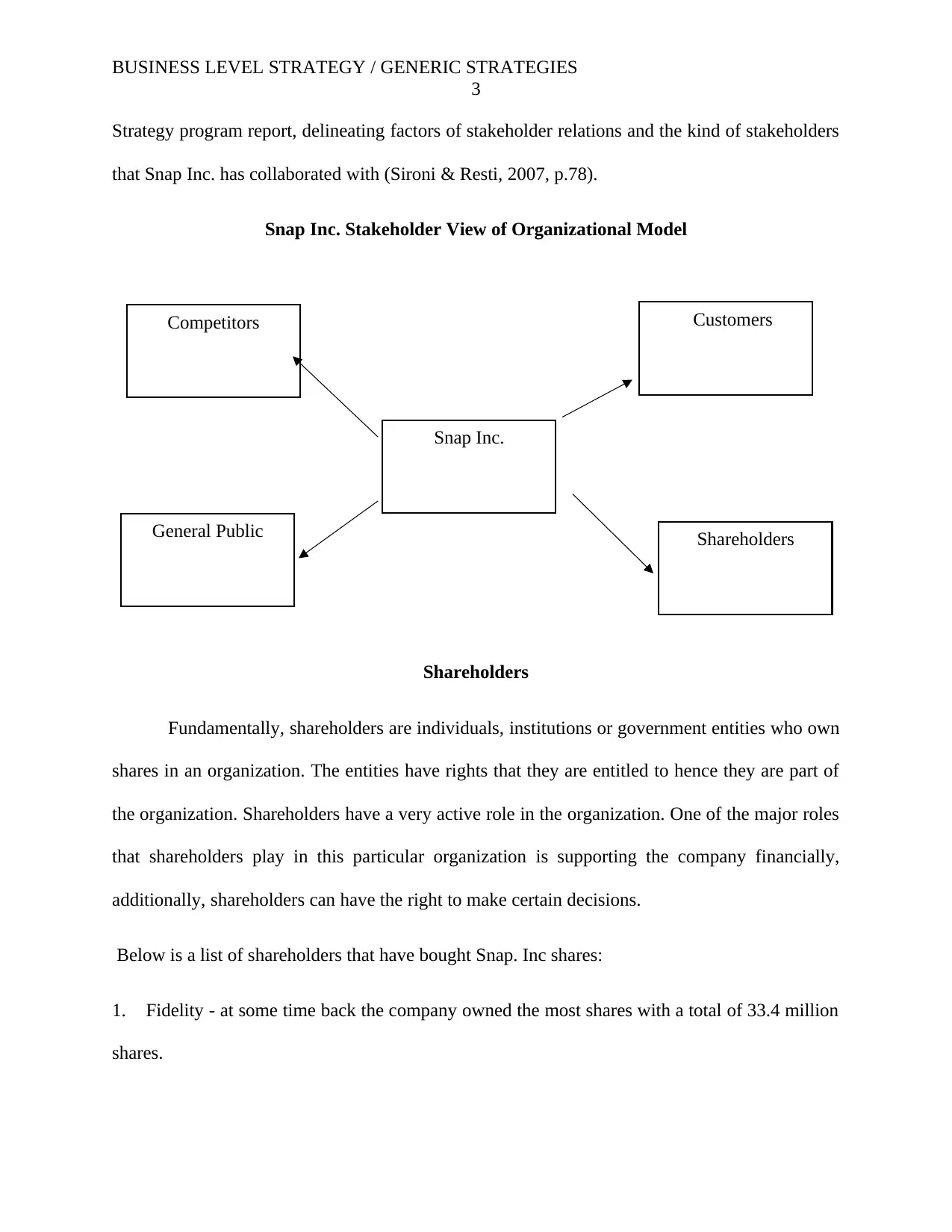
BUSINESS LEVEL STRATEGY / GENERIC STRATEGIES
3
Strategy program report, delineating factors of stakeholder relations and the kind of stakeholders
that Snap Inc. has collaborated with (Sironi & Resti, 2007, p.78).
Snap Inc. Stakeholder View of Organizational Model
Shareholders
Fundamentally, shareholders are individuals, institutions or government entities who own
shares in an organization. The entities have rights that they are entitled to hence they are part of
the organization. Shareholders have a very active role in the organization. One of the major roles
that shareholders play in this particular organization is supporting the company financially,
additionally, shareholders can have the right to make certain decisions.
Below is a list of shareholders that have bought Snap. Inc shares:
1. Fidelity - at some time back the company owned the most shares with a total of 33.4 million
shares.
Competitors Customers
General Public Shareholders
Snap Inc.
3
Strategy program report, delineating factors of stakeholder relations and the kind of stakeholders
that Snap Inc. has collaborated with (Sironi & Resti, 2007, p.78).
Snap Inc. Stakeholder View of Organizational Model
Shareholders
Fundamentally, shareholders are individuals, institutions or government entities who own
shares in an organization. The entities have rights that they are entitled to hence they are part of
the organization. Shareholders have a very active role in the organization. One of the major roles
that shareholders play in this particular organization is supporting the company financially,
additionally, shareholders can have the right to make certain decisions.
Below is a list of shareholders that have bought Snap. Inc shares:
1. Fidelity - at some time back the company owned the most shares with a total of 33.4 million
shares.
Competitors Customers
General Public Shareholders
Snap Inc.
⊘ This is a preview!⊘
Do you want full access?
Subscribe today to unlock all pages.

Trusted by 1+ million students worldwide
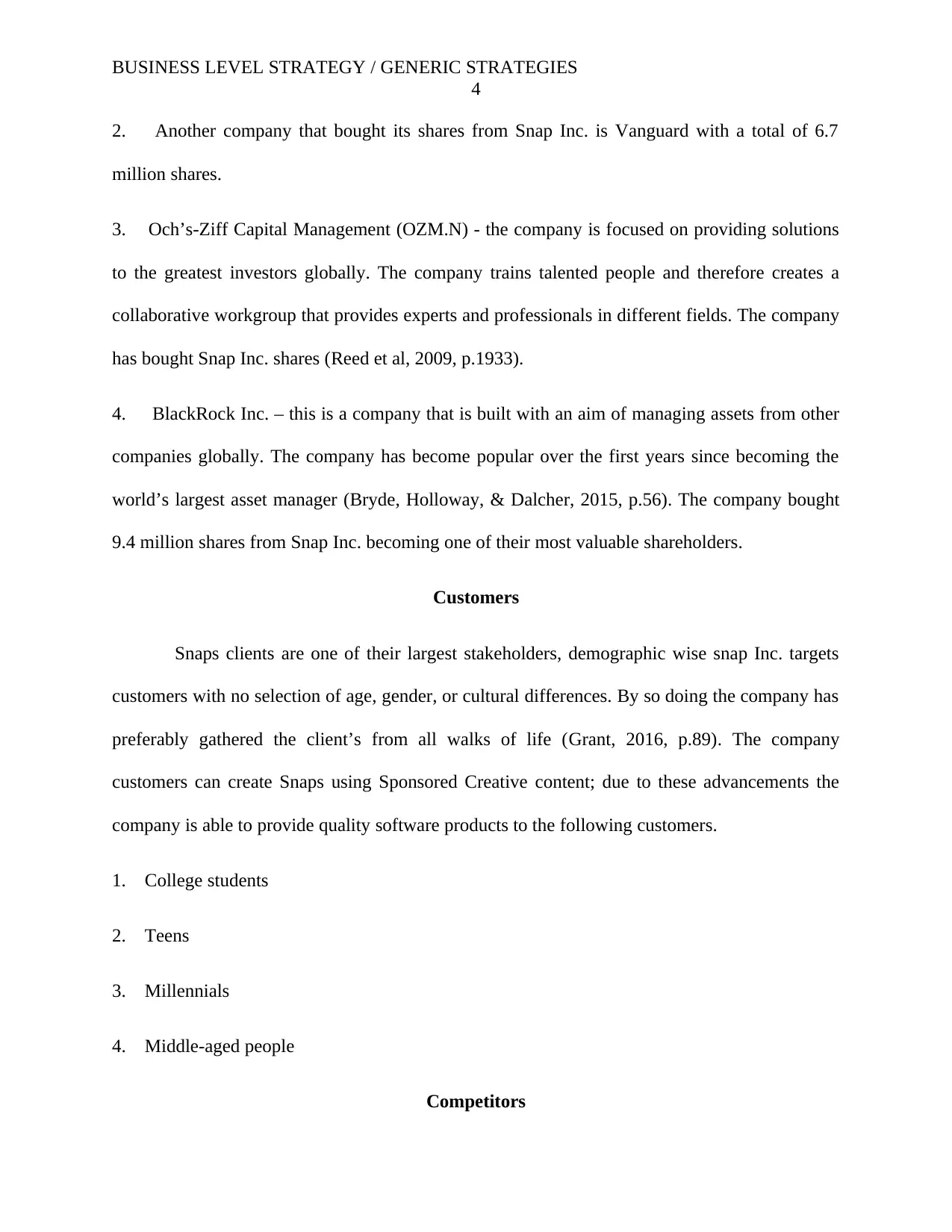
BUSINESS LEVEL STRATEGY / GENERIC STRATEGIES
4
2. Another company that bought its shares from Snap Inc. is Vanguard with a total of 6.7
million shares.
3. Och’s-Ziff Capital Management (OZM.N) - the company is focused on providing solutions
to the greatest investors globally. The company trains talented people and therefore creates a
collaborative workgroup that provides experts and professionals in different fields. The company
has bought Snap Inc. shares (Reed et al, 2009, p.1933).
4. BlackRock Inc. – this is a company that is built with an aim of managing assets from other
companies globally. The company has become popular over the first years since becoming the
world’s largest asset manager (Bryde, Holloway, & Dalcher, 2015, p.56). The company bought
9.4 million shares from Snap Inc. becoming one of their most valuable shareholders.
Customers
Snaps clients are one of their largest stakeholders, demographic wise snap Inc. targets
customers with no selection of age, gender, or cultural differences. By so doing the company has
preferably gathered the client’s from all walks of life (Grant, 2016, p.89). The company
customers can create Snaps using Sponsored Creative content; due to these advancements the
company is able to provide quality software products to the following customers.
1. College students
2. Teens
3. Millennials
4. Middle-aged people
Competitors
4
2. Another company that bought its shares from Snap Inc. is Vanguard with a total of 6.7
million shares.
3. Och’s-Ziff Capital Management (OZM.N) - the company is focused on providing solutions
to the greatest investors globally. The company trains talented people and therefore creates a
collaborative workgroup that provides experts and professionals in different fields. The company
has bought Snap Inc. shares (Reed et al, 2009, p.1933).
4. BlackRock Inc. – this is a company that is built with an aim of managing assets from other
companies globally. The company has become popular over the first years since becoming the
world’s largest asset manager (Bryde, Holloway, & Dalcher, 2015, p.56). The company bought
9.4 million shares from Snap Inc. becoming one of their most valuable shareholders.
Customers
Snaps clients are one of their largest stakeholders, demographic wise snap Inc. targets
customers with no selection of age, gender, or cultural differences. By so doing the company has
preferably gathered the client’s from all walks of life (Grant, 2016, p.89). The company
customers can create Snaps using Sponsored Creative content; due to these advancements the
company is able to provide quality software products to the following customers.
1. College students
2. Teens
3. Millennials
4. Middle-aged people
Competitors
Paraphrase This Document
Need a fresh take? Get an instant paraphrase of this document with our AI Paraphraser
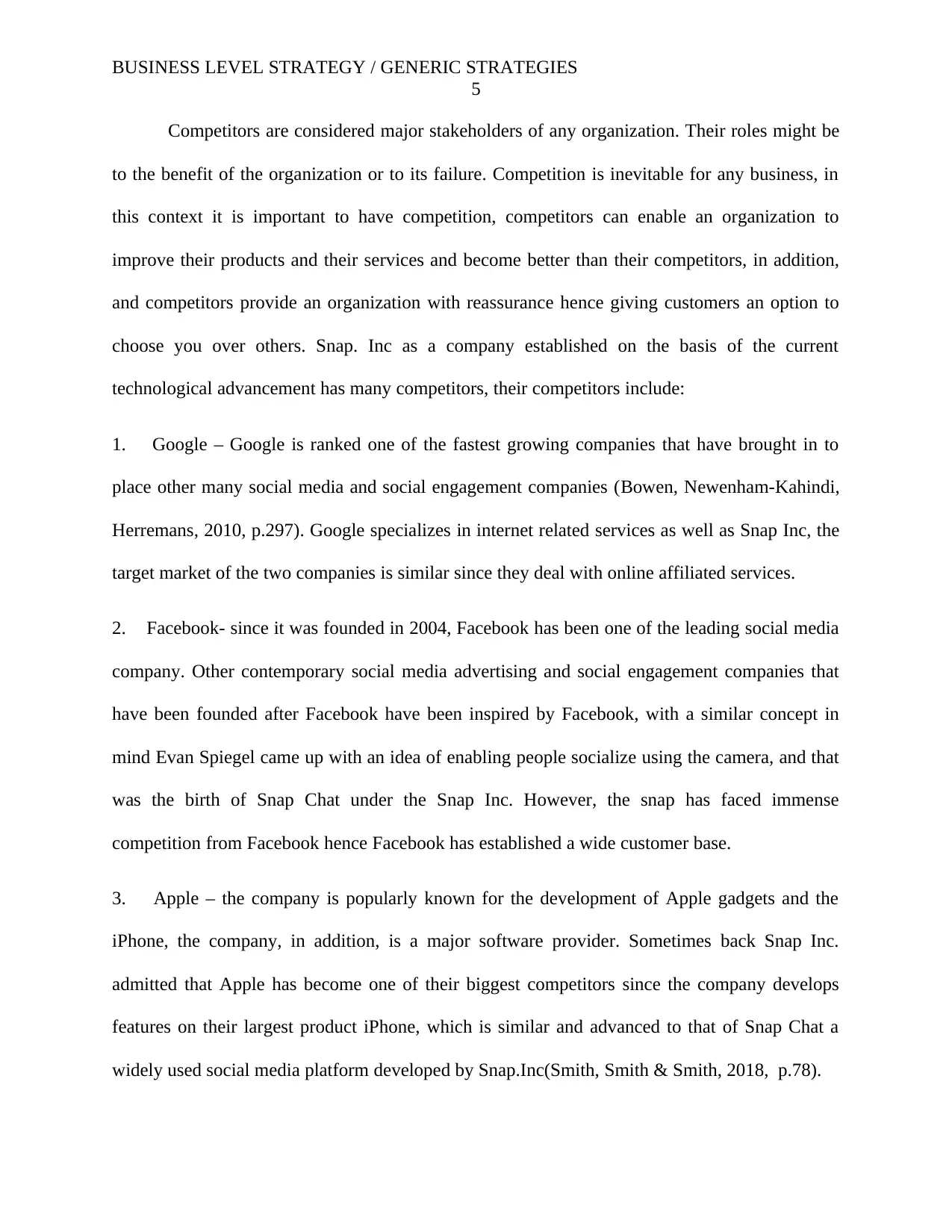
BUSINESS LEVEL STRATEGY / GENERIC STRATEGIES
5
Competitors are considered major stakeholders of any organization. Their roles might be
to the benefit of the organization or to its failure. Competition is inevitable for any business, in
this context it is important to have competition, competitors can enable an organization to
improve their products and their services and become better than their competitors, in addition,
and competitors provide an organization with reassurance hence giving customers an option to
choose you over others. Snap. Inc as a company established on the basis of the current
technological advancement has many competitors, their competitors include:
1. Google – Google is ranked one of the fastest growing companies that have brought in to
place other many social media and social engagement companies (Bowen, Newenham-Kahindi,
Herremans, 2010, p.297). Google specializes in internet related services as well as Snap Inc, the
target market of the two companies is similar since they deal with online affiliated services.
2. Facebook- since it was founded in 2004, Facebook has been one of the leading social media
company. Other contemporary social media advertising and social engagement companies that
have been founded after Facebook have been inspired by Facebook, with a similar concept in
mind Evan Spiegel came up with an idea of enabling people socialize using the camera, and that
was the birth of Snap Chat under the Snap Inc. However, the snap has faced immense
competition from Facebook hence Facebook has established a wide customer base.
3. Apple – the company is popularly known for the development of Apple gadgets and the
iPhone, the company, in addition, is a major software provider. Sometimes back Snap Inc.
admitted that Apple has become one of their biggest competitors since the company develops
features on their largest product iPhone, which is similar and advanced to that of Snap Chat a
widely used social media platform developed by Snap.Inc(Smith, Smith & Smith, 2018, p.78).
5
Competitors are considered major stakeholders of any organization. Their roles might be
to the benefit of the organization or to its failure. Competition is inevitable for any business, in
this context it is important to have competition, competitors can enable an organization to
improve their products and their services and become better than their competitors, in addition,
and competitors provide an organization with reassurance hence giving customers an option to
choose you over others. Snap. Inc as a company established on the basis of the current
technological advancement has many competitors, their competitors include:
1. Google – Google is ranked one of the fastest growing companies that have brought in to
place other many social media and social engagement companies (Bowen, Newenham-Kahindi,
Herremans, 2010, p.297). Google specializes in internet related services as well as Snap Inc, the
target market of the two companies is similar since they deal with online affiliated services.
2. Facebook- since it was founded in 2004, Facebook has been one of the leading social media
company. Other contemporary social media advertising and social engagement companies that
have been founded after Facebook have been inspired by Facebook, with a similar concept in
mind Evan Spiegel came up with an idea of enabling people socialize using the camera, and that
was the birth of Snap Chat under the Snap Inc. However, the snap has faced immense
competition from Facebook hence Facebook has established a wide customer base.
3. Apple – the company is popularly known for the development of Apple gadgets and the
iPhone, the company, in addition, is a major software provider. Sometimes back Snap Inc.
admitted that Apple has become one of their biggest competitors since the company develops
features on their largest product iPhone, which is similar and advanced to that of Snap Chat a
widely used social media platform developed by Snap.Inc(Smith, Smith & Smith, 2018, p.78).
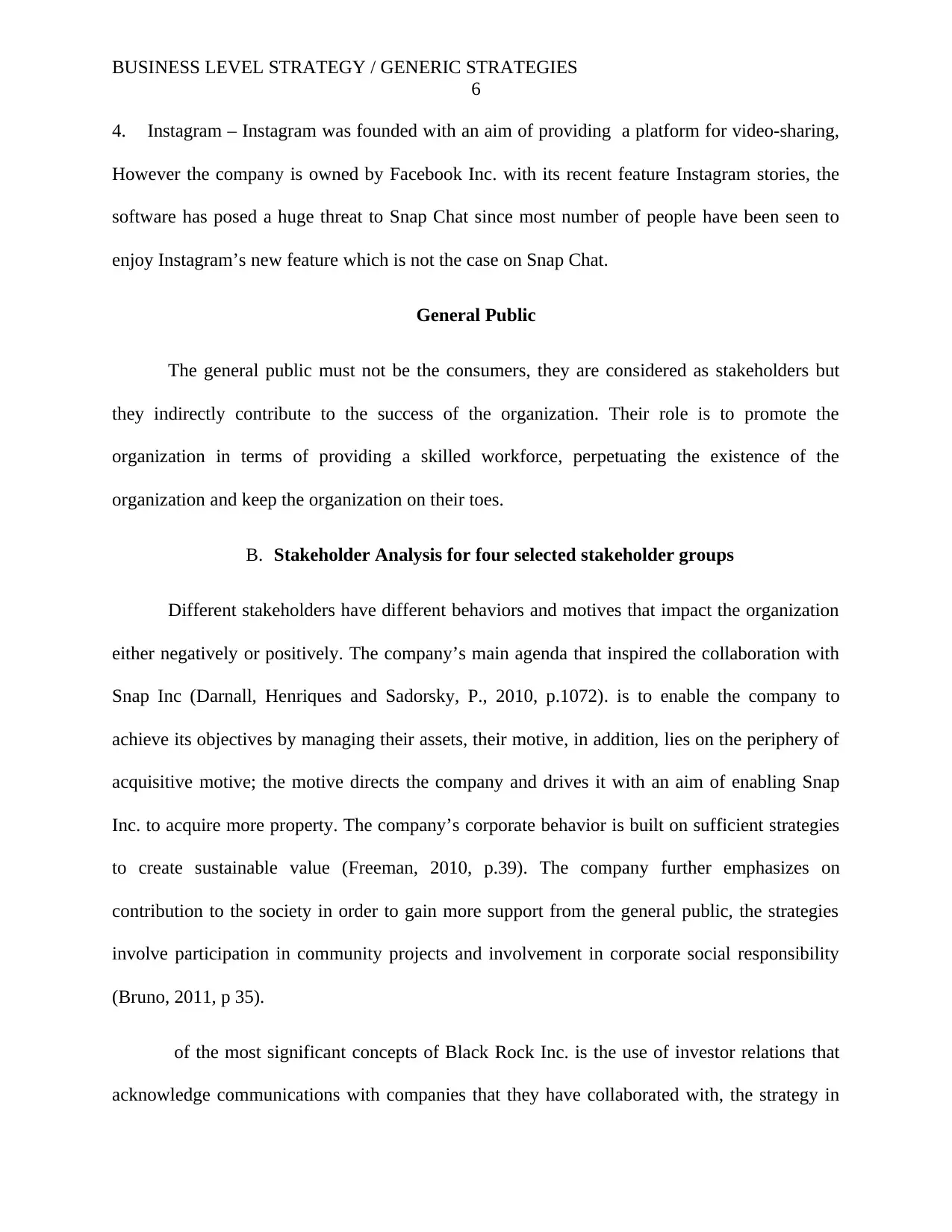
BUSINESS LEVEL STRATEGY / GENERIC STRATEGIES
6
4. Instagram – Instagram was founded with an aim of providing a platform for video-sharing,
However the company is owned by Facebook Inc. with its recent feature Instagram stories, the
software has posed a huge threat to Snap Chat since most number of people have been seen to
enjoy Instagram’s new feature which is not the case on Snap Chat.
General Public
The general public must not be the consumers, they are considered as stakeholders but
they indirectly contribute to the success of the organization. Their role is to promote the
organization in terms of providing a skilled workforce, perpetuating the existence of the
organization and keep the organization on their toes.
B. Stakeholder Analysis for four selected stakeholder groups
Different stakeholders have different behaviors and motives that impact the organization
either negatively or positively. The company’s main agenda that inspired the collaboration with
Snap Inc (Darnall, Henriques and Sadorsky, P., 2010, p.1072). is to enable the company to
achieve its objectives by managing their assets, their motive, in addition, lies on the periphery of
acquisitive motive; the motive directs the company and drives it with an aim of enabling Snap
Inc. to acquire more property. The company’s corporate behavior is built on sufficient strategies
to create sustainable value (Freeman, 2010, p.39). The company further emphasizes on
contribution to the society in order to gain more support from the general public, the strategies
involve participation in community projects and involvement in corporate social responsibility
(Bruno, 2011, p 35).
of the most significant concepts of Black Rock Inc. is the use of investor relations that
acknowledge communications with companies that they have collaborated with, the strategy in
6
4. Instagram – Instagram was founded with an aim of providing a platform for video-sharing,
However the company is owned by Facebook Inc. with its recent feature Instagram stories, the
software has posed a huge threat to Snap Chat since most number of people have been seen to
enjoy Instagram’s new feature which is not the case on Snap Chat.
General Public
The general public must not be the consumers, they are considered as stakeholders but
they indirectly contribute to the success of the organization. Their role is to promote the
organization in terms of providing a skilled workforce, perpetuating the existence of the
organization and keep the organization on their toes.
B. Stakeholder Analysis for four selected stakeholder groups
Different stakeholders have different behaviors and motives that impact the organization
either negatively or positively. The company’s main agenda that inspired the collaboration with
Snap Inc (Darnall, Henriques and Sadorsky, P., 2010, p.1072). is to enable the company to
achieve its objectives by managing their assets, their motive, in addition, lies on the periphery of
acquisitive motive; the motive directs the company and drives it with an aim of enabling Snap
Inc. to acquire more property. The company’s corporate behavior is built on sufficient strategies
to create sustainable value (Freeman, 2010, p.39). The company further emphasizes on
contribution to the society in order to gain more support from the general public, the strategies
involve participation in community projects and involvement in corporate social responsibility
(Bruno, 2011, p 35).
of the most significant concepts of Black Rock Inc. is the use of investor relations that
acknowledge communications with companies that they have collaborated with, the strategy in
⊘ This is a preview!⊘
Do you want full access?
Subscribe today to unlock all pages.

Trusted by 1+ million students worldwide
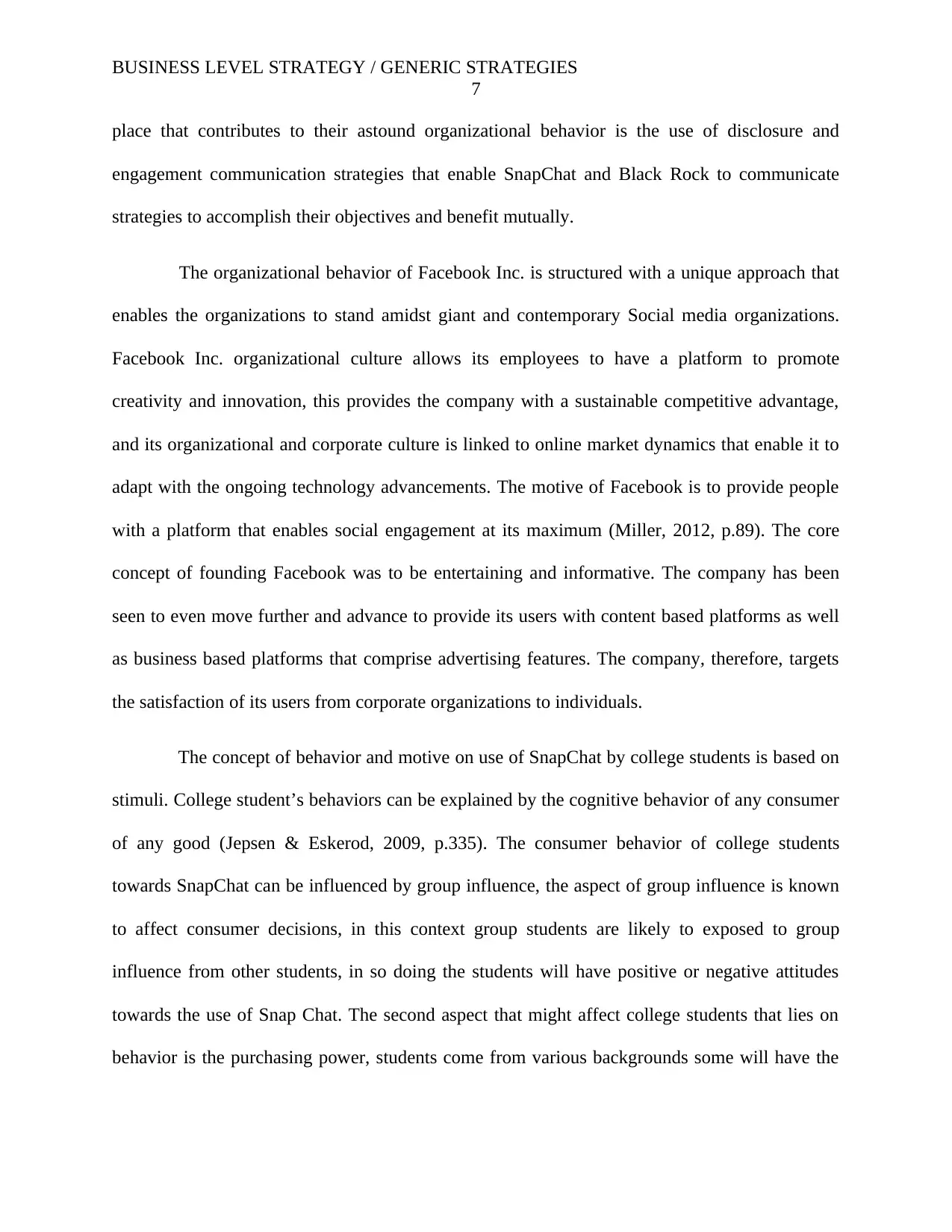
BUSINESS LEVEL STRATEGY / GENERIC STRATEGIES
7
place that contributes to their astound organizational behavior is the use of disclosure and
engagement communication strategies that enable SnapChat and Black Rock to communicate
strategies to accomplish their objectives and benefit mutually.
The organizational behavior of Facebook Inc. is structured with a unique approach that
enables the organizations to stand amidst giant and contemporary Social media organizations.
Facebook Inc. organizational culture allows its employees to have a platform to promote
creativity and innovation, this provides the company with a sustainable competitive advantage,
and its organizational and corporate culture is linked to online market dynamics that enable it to
adapt with the ongoing technology advancements. The motive of Facebook is to provide people
with a platform that enables social engagement at its maximum (Miller, 2012, p.89). The core
concept of founding Facebook was to be entertaining and informative. The company has been
seen to even move further and advance to provide its users with content based platforms as well
as business based platforms that comprise advertising features. The company, therefore, targets
the satisfaction of its users from corporate organizations to individuals.
The concept of behavior and motive on use of SnapChat by college students is based on
stimuli. College student’s behaviors can be explained by the cognitive behavior of any consumer
of any good (Jepsen & Eskerod, 2009, p.335). The consumer behavior of college students
towards SnapChat can be influenced by group influence, the aspect of group influence is known
to affect consumer decisions, in this context group students are likely to exposed to group
influence from other students, in so doing the students will have positive or negative attitudes
towards the use of Snap Chat. The second aspect that might affect college students that lies on
behavior is the purchasing power, students come from various backgrounds some will have the
7
place that contributes to their astound organizational behavior is the use of disclosure and
engagement communication strategies that enable SnapChat and Black Rock to communicate
strategies to accomplish their objectives and benefit mutually.
The organizational behavior of Facebook Inc. is structured with a unique approach that
enables the organizations to stand amidst giant and contemporary Social media organizations.
Facebook Inc. organizational culture allows its employees to have a platform to promote
creativity and innovation, this provides the company with a sustainable competitive advantage,
and its organizational and corporate culture is linked to online market dynamics that enable it to
adapt with the ongoing technology advancements. The motive of Facebook is to provide people
with a platform that enables social engagement at its maximum (Miller, 2012, p.89). The core
concept of founding Facebook was to be entertaining and informative. The company has been
seen to even move further and advance to provide its users with content based platforms as well
as business based platforms that comprise advertising features. The company, therefore, targets
the satisfaction of its users from corporate organizations to individuals.
The concept of behavior and motive on use of SnapChat by college students is based on
stimuli. College student’s behaviors can be explained by the cognitive behavior of any consumer
of any good (Jepsen & Eskerod, 2009, p.335). The consumer behavior of college students
towards SnapChat can be influenced by group influence, the aspect of group influence is known
to affect consumer decisions, in this context group students are likely to exposed to group
influence from other students, in so doing the students will have positive or negative attitudes
towards the use of Snap Chat. The second aspect that might affect college students that lies on
behavior is the purchasing power, students come from various backgrounds some will have the
Paraphrase This Document
Need a fresh take? Get an instant paraphrase of this document with our AI Paraphraser
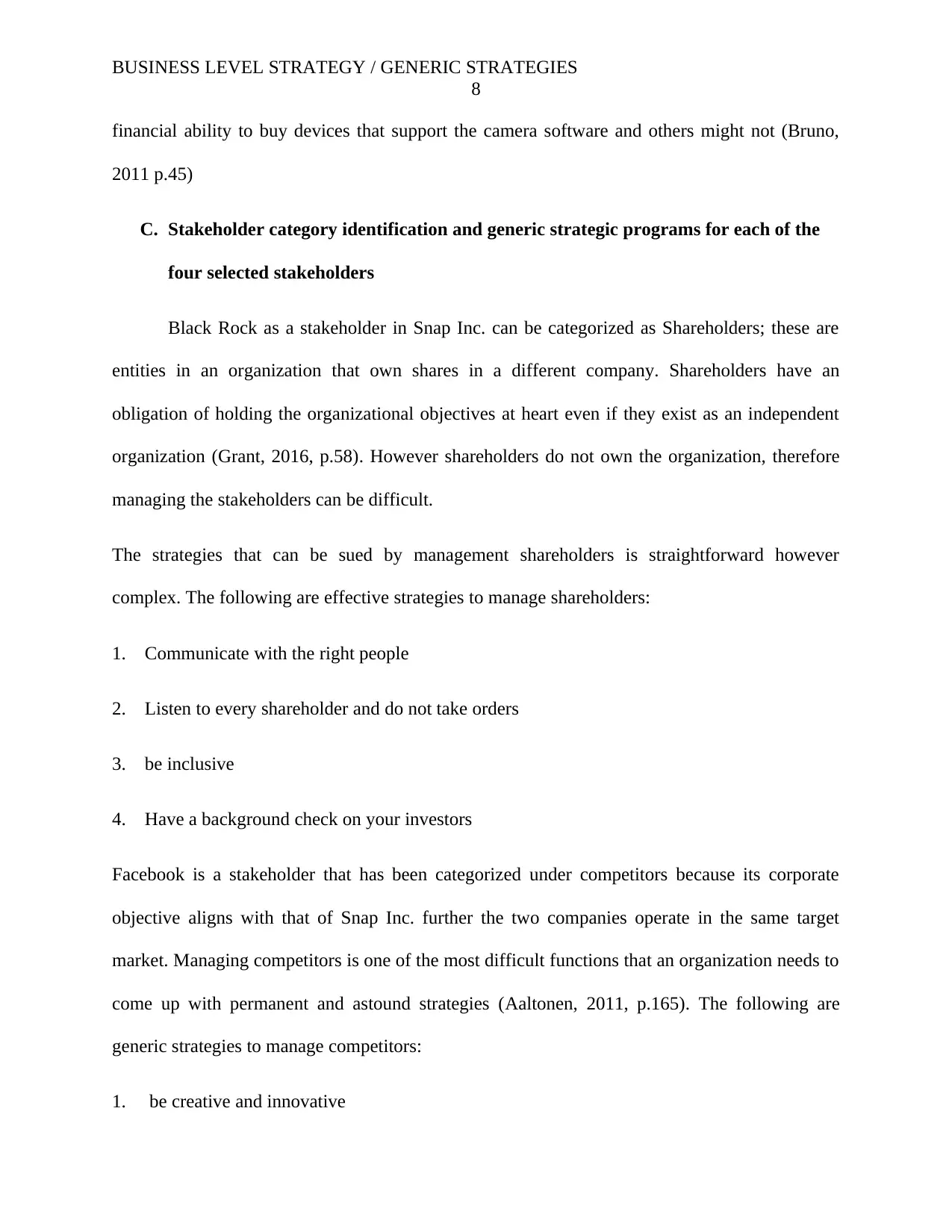
BUSINESS LEVEL STRATEGY / GENERIC STRATEGIES
8
financial ability to buy devices that support the camera software and others might not (Bruno,
2011 p.45)
C. Stakeholder category identification and generic strategic programs for each of the
four selected stakeholders
Black Rock as a stakeholder in Snap Inc. can be categorized as Shareholders; these are
entities in an organization that own shares in a different company. Shareholders have an
obligation of holding the organizational objectives at heart even if they exist as an independent
organization (Grant, 2016, p.58). However shareholders do not own the organization, therefore
managing the stakeholders can be difficult.
The strategies that can be sued by management shareholders is straightforward however
complex. The following are effective strategies to manage shareholders:
1. Communicate with the right people
2. Listen to every shareholder and do not take orders
3. be inclusive
4. Have a background check on your investors
Facebook is a stakeholder that has been categorized under competitors because its corporate
objective aligns with that of Snap Inc. further the two companies operate in the same target
market. Managing competitors is one of the most difficult functions that an organization needs to
come up with permanent and astound strategies (Aaltonen, 2011, p.165). The following are
generic strategies to manage competitors:
1. be creative and innovative
8
financial ability to buy devices that support the camera software and others might not (Bruno,
2011 p.45)
C. Stakeholder category identification and generic strategic programs for each of the
four selected stakeholders
Black Rock as a stakeholder in Snap Inc. can be categorized as Shareholders; these are
entities in an organization that own shares in a different company. Shareholders have an
obligation of holding the organizational objectives at heart even if they exist as an independent
organization (Grant, 2016, p.58). However shareholders do not own the organization, therefore
managing the stakeholders can be difficult.
The strategies that can be sued by management shareholders is straightforward however
complex. The following are effective strategies to manage shareholders:
1. Communicate with the right people
2. Listen to every shareholder and do not take orders
3. be inclusive
4. Have a background check on your investors
Facebook is a stakeholder that has been categorized under competitors because its corporate
objective aligns with that of Snap Inc. further the two companies operate in the same target
market. Managing competitors is one of the most difficult functions that an organization needs to
come up with permanent and astound strategies (Aaltonen, 2011, p.165). The following are
generic strategies to manage competitors:
1. be creative and innovative
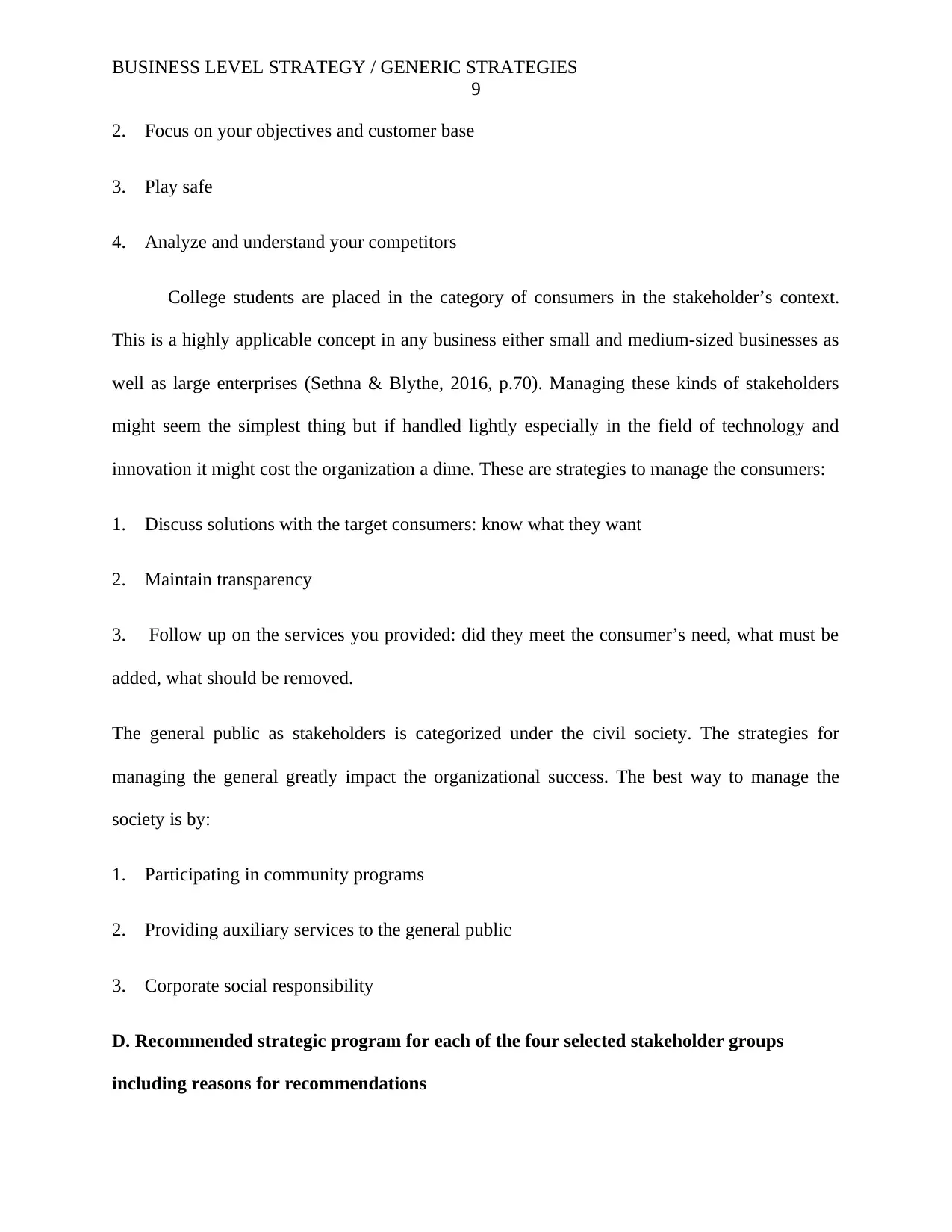
BUSINESS LEVEL STRATEGY / GENERIC STRATEGIES
9
2. Focus on your objectives and customer base
3. Play safe
4. Analyze and understand your competitors
College students are placed in the category of consumers in the stakeholder’s context.
This is a highly applicable concept in any business either small and medium-sized businesses as
well as large enterprises (Sethna & Blythe, 2016, p.70). Managing these kinds of stakeholders
might seem the simplest thing but if handled lightly especially in the field of technology and
innovation it might cost the organization a dime. These are strategies to manage the consumers:
1. Discuss solutions with the target consumers: know what they want
2. Maintain transparency
3. Follow up on the services you provided: did they meet the consumer’s need, what must be
added, what should be removed.
The general public as stakeholders is categorized under the civil society. The strategies for
managing the general greatly impact the organizational success. The best way to manage the
society is by:
1. Participating in community programs
2. Providing auxiliary services to the general public
3. Corporate social responsibility
D. Recommended strategic program for each of the four selected stakeholder groups
including reasons for recommendations
9
2. Focus on your objectives and customer base
3. Play safe
4. Analyze and understand your competitors
College students are placed in the category of consumers in the stakeholder’s context.
This is a highly applicable concept in any business either small and medium-sized businesses as
well as large enterprises (Sethna & Blythe, 2016, p.70). Managing these kinds of stakeholders
might seem the simplest thing but if handled lightly especially in the field of technology and
innovation it might cost the organization a dime. These are strategies to manage the consumers:
1. Discuss solutions with the target consumers: know what they want
2. Maintain transparency
3. Follow up on the services you provided: did they meet the consumer’s need, what must be
added, what should be removed.
The general public as stakeholders is categorized under the civil society. The strategies for
managing the general greatly impact the organizational success. The best way to manage the
society is by:
1. Participating in community programs
2. Providing auxiliary services to the general public
3. Corporate social responsibility
D. Recommended strategic program for each of the four selected stakeholder groups
including reasons for recommendations
⊘ This is a preview!⊘
Do you want full access?
Subscribe today to unlock all pages.

Trusted by 1+ million students worldwide
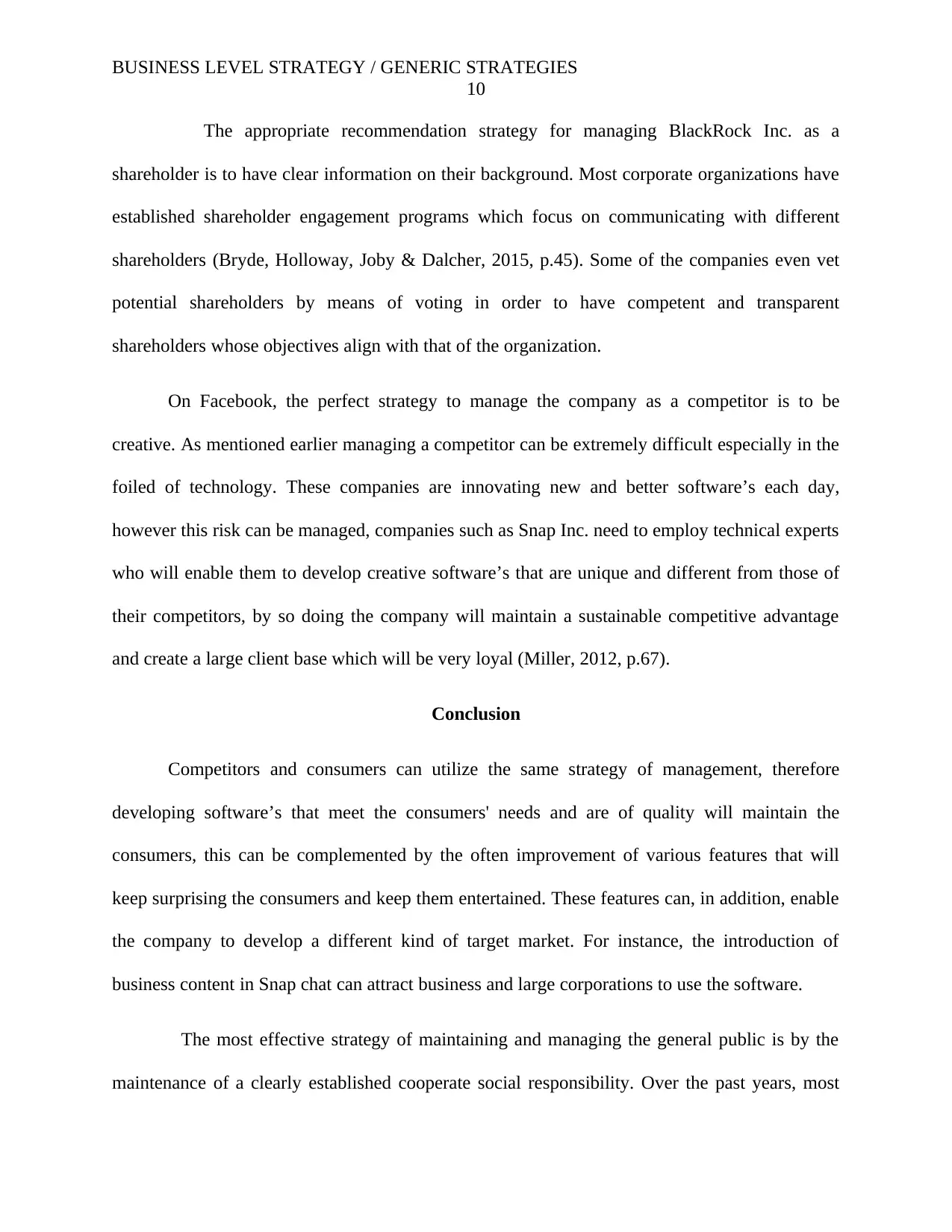
BUSINESS LEVEL STRATEGY / GENERIC STRATEGIES
10
The appropriate recommendation strategy for managing BlackRock Inc. as a
shareholder is to have clear information on their background. Most corporate organizations have
established shareholder engagement programs which focus on communicating with different
shareholders (Bryde, Holloway, Joby & Dalcher, 2015, p.45). Some of the companies even vet
potential shareholders by means of voting in order to have competent and transparent
shareholders whose objectives align with that of the organization.
On Facebook, the perfect strategy to manage the company as a competitor is to be
creative. As mentioned earlier managing a competitor can be extremely difficult especially in the
foiled of technology. These companies are innovating new and better software’s each day,
however this risk can be managed, companies such as Snap Inc. need to employ technical experts
who will enable them to develop creative software’s that are unique and different from those of
their competitors, by so doing the company will maintain a sustainable competitive advantage
and create a large client base which will be very loyal (Miller, 2012, p.67).
Conclusion
Competitors and consumers can utilize the same strategy of management, therefore
developing software’s that meet the consumers' needs and are of quality will maintain the
consumers, this can be complemented by the often improvement of various features that will
keep surprising the consumers and keep them entertained. These features can, in addition, enable
the company to develop a different kind of target market. For instance, the introduction of
business content in Snap chat can attract business and large corporations to use the software.
The most effective strategy of maintaining and managing the general public is by the
maintenance of a clearly established cooperate social responsibility. Over the past years, most
10
The appropriate recommendation strategy for managing BlackRock Inc. as a
shareholder is to have clear information on their background. Most corporate organizations have
established shareholder engagement programs which focus on communicating with different
shareholders (Bryde, Holloway, Joby & Dalcher, 2015, p.45). Some of the companies even vet
potential shareholders by means of voting in order to have competent and transparent
shareholders whose objectives align with that of the organization.
On Facebook, the perfect strategy to manage the company as a competitor is to be
creative. As mentioned earlier managing a competitor can be extremely difficult especially in the
foiled of technology. These companies are innovating new and better software’s each day,
however this risk can be managed, companies such as Snap Inc. need to employ technical experts
who will enable them to develop creative software’s that are unique and different from those of
their competitors, by so doing the company will maintain a sustainable competitive advantage
and create a large client base which will be very loyal (Miller, 2012, p.67).
Conclusion
Competitors and consumers can utilize the same strategy of management, therefore
developing software’s that meet the consumers' needs and are of quality will maintain the
consumers, this can be complemented by the often improvement of various features that will
keep surprising the consumers and keep them entertained. These features can, in addition, enable
the company to develop a different kind of target market. For instance, the introduction of
business content in Snap chat can attract business and large corporations to use the software.
The most effective strategy of maintaining and managing the general public is by the
maintenance of a clearly established cooperate social responsibility. Over the past years, most
Paraphrase This Document
Need a fresh take? Get an instant paraphrase of this document with our AI Paraphraser
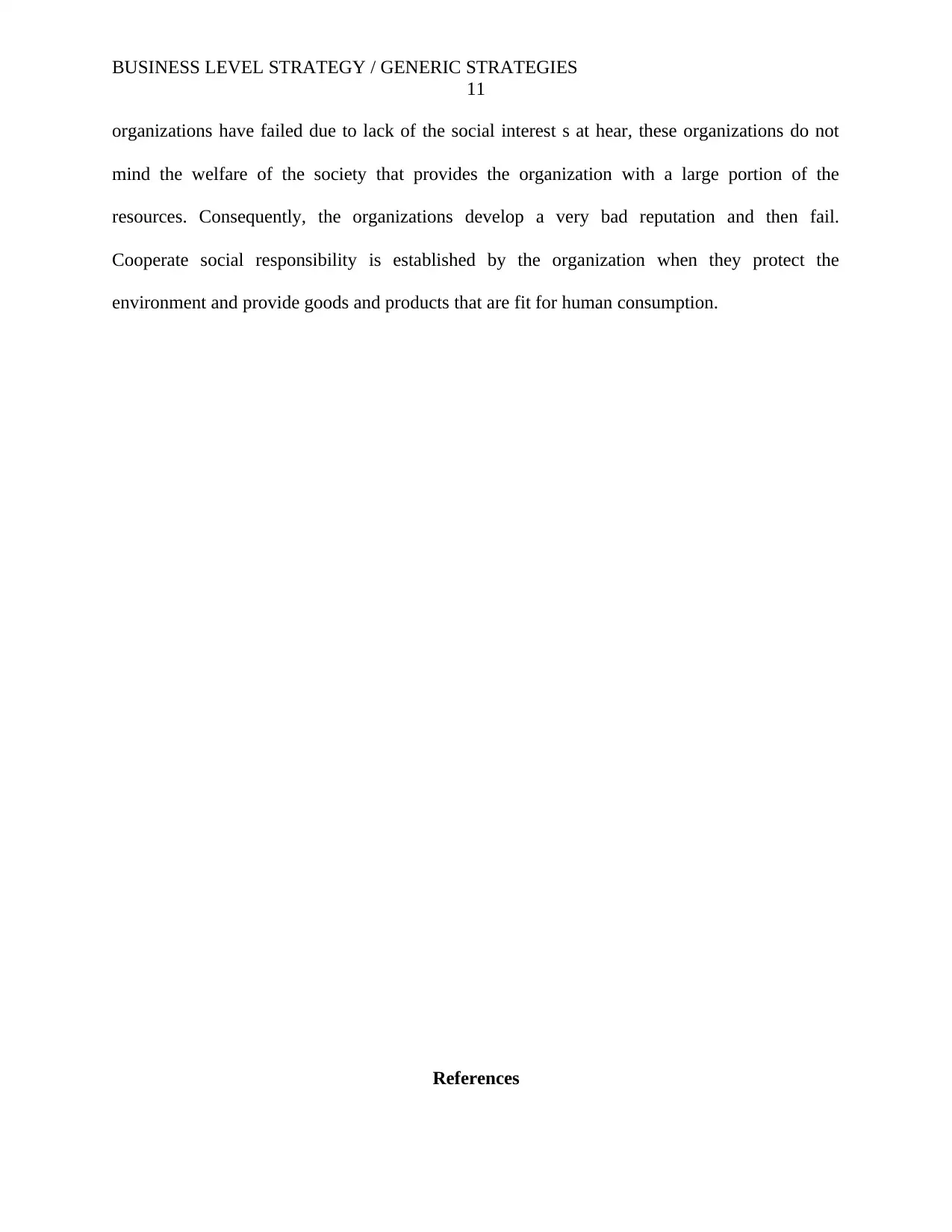
BUSINESS LEVEL STRATEGY / GENERIC STRATEGIES
11
organizations have failed due to lack of the social interest s at hear, these organizations do not
mind the welfare of the society that provides the organization with a large portion of the
resources. Consequently, the organizations develop a very bad reputation and then fail.
Cooperate social responsibility is established by the organization when they protect the
environment and provide goods and products that are fit for human consumption.
References
11
organizations have failed due to lack of the social interest s at hear, these organizations do not
mind the welfare of the society that provides the organization with a large portion of the
resources. Consequently, the organizations develop a very bad reputation and then fail.
Cooperate social responsibility is established by the organization when they protect the
environment and provide goods and products that are fit for human consumption.
References
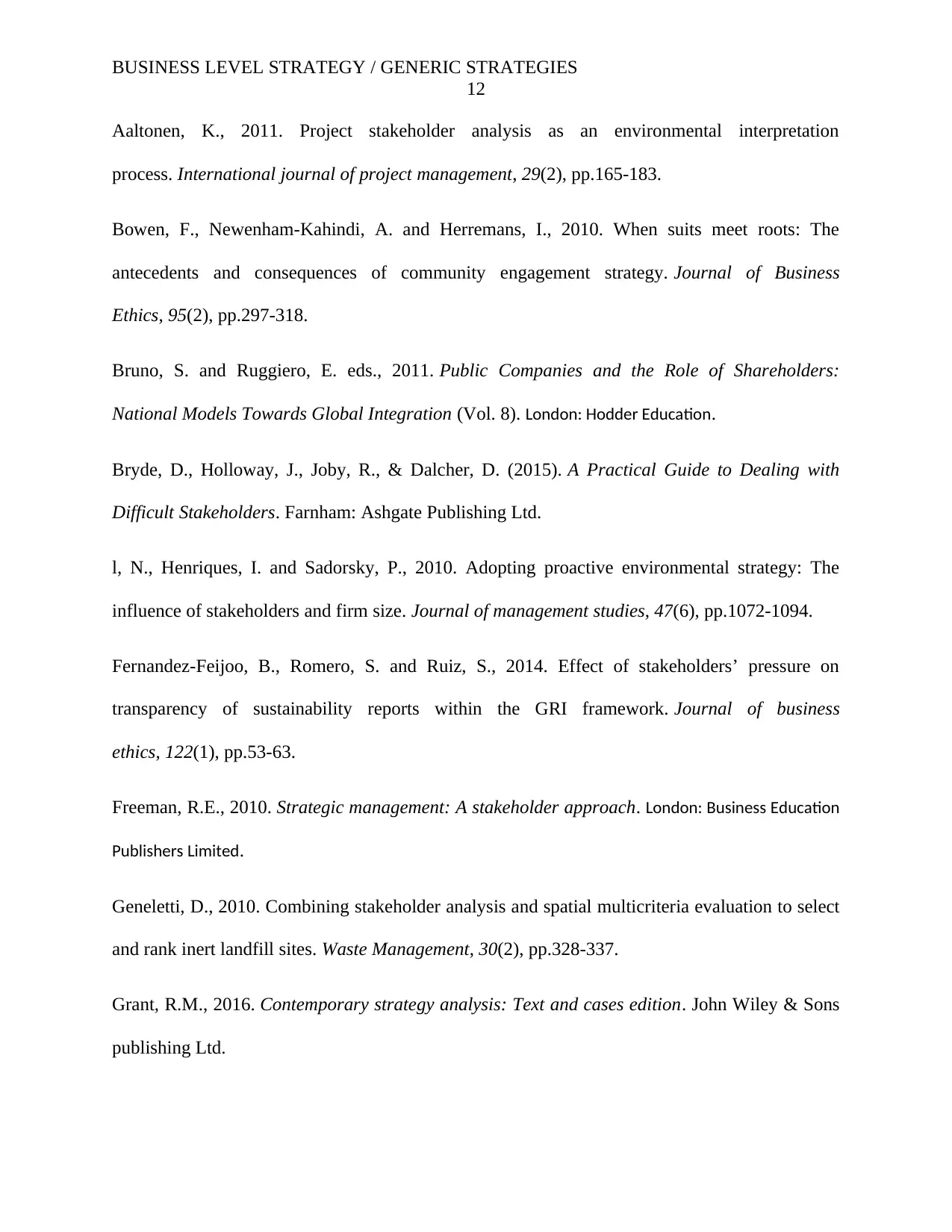
BUSINESS LEVEL STRATEGY / GENERIC STRATEGIES
12
Aaltonen, K., 2011. Project stakeholder analysis as an environmental interpretation
process. International journal of project management, 29(2), pp.165-183.
Bowen, F., Newenham-Kahindi, A. and Herremans, I., 2010. When suits meet roots: The
antecedents and consequences of community engagement strategy. Journal of Business
Ethics, 95(2), pp.297-318.
Bruno, S. and Ruggiero, E. eds., 2011. Public Companies and the Role of Shareholders:
National Models Towards Global Integration (Vol. 8). London: Hodder Education.
Bryde, D., Holloway, J., Joby, R., & Dalcher, D. (2015). A Practical Guide to Dealing with
Difficult Stakeholders. Farnham: Ashgate Publishing Ltd.
l, N., Henriques, I. and Sadorsky, P., 2010. Adopting proactive environmental strategy: The
influence of stakeholders and firm size. Journal of management studies, 47(6), pp.1072-1094.
Fernandez-Feijoo, B., Romero, S. and Ruiz, S., 2014. Effect of stakeholders’ pressure on
transparency of sustainability reports within the GRI framework. Journal of business
ethics, 122(1), pp.53-63.
Freeman, R.E., 2010. Strategic management: A stakeholder approach. London: Business Education
Publishers Limited.
Geneletti, D., 2010. Combining stakeholder analysis and spatial multicriteria evaluation to select
and rank inert landfill sites. Waste Management, 30(2), pp.328-337.
Grant, R.M., 2016. Contemporary strategy analysis: Text and cases edition. John Wiley & Sons
publishing Ltd.
12
Aaltonen, K., 2011. Project stakeholder analysis as an environmental interpretation
process. International journal of project management, 29(2), pp.165-183.
Bowen, F., Newenham-Kahindi, A. and Herremans, I., 2010. When suits meet roots: The
antecedents and consequences of community engagement strategy. Journal of Business
Ethics, 95(2), pp.297-318.
Bruno, S. and Ruggiero, E. eds., 2011. Public Companies and the Role of Shareholders:
National Models Towards Global Integration (Vol. 8). London: Hodder Education.
Bryde, D., Holloway, J., Joby, R., & Dalcher, D. (2015). A Practical Guide to Dealing with
Difficult Stakeholders. Farnham: Ashgate Publishing Ltd.
l, N., Henriques, I. and Sadorsky, P., 2010. Adopting proactive environmental strategy: The
influence of stakeholders and firm size. Journal of management studies, 47(6), pp.1072-1094.
Fernandez-Feijoo, B., Romero, S. and Ruiz, S., 2014. Effect of stakeholders’ pressure on
transparency of sustainability reports within the GRI framework. Journal of business
ethics, 122(1), pp.53-63.
Freeman, R.E., 2010. Strategic management: A stakeholder approach. London: Business Education
Publishers Limited.
Geneletti, D., 2010. Combining stakeholder analysis and spatial multicriteria evaluation to select
and rank inert landfill sites. Waste Management, 30(2), pp.328-337.
Grant, R.M., 2016. Contemporary strategy analysis: Text and cases edition. John Wiley & Sons
publishing Ltd.
⊘ This is a preview!⊘
Do you want full access?
Subscribe today to unlock all pages.

Trusted by 1+ million students worldwide
1 out of 13
Related Documents
Your All-in-One AI-Powered Toolkit for Academic Success.
+13062052269
info@desklib.com
Available 24*7 on WhatsApp / Email
![[object Object]](/_next/static/media/star-bottom.7253800d.svg)
Unlock your academic potential
Copyright © 2020–2025 A2Z Services. All Rights Reserved. Developed and managed by ZUCOL.




